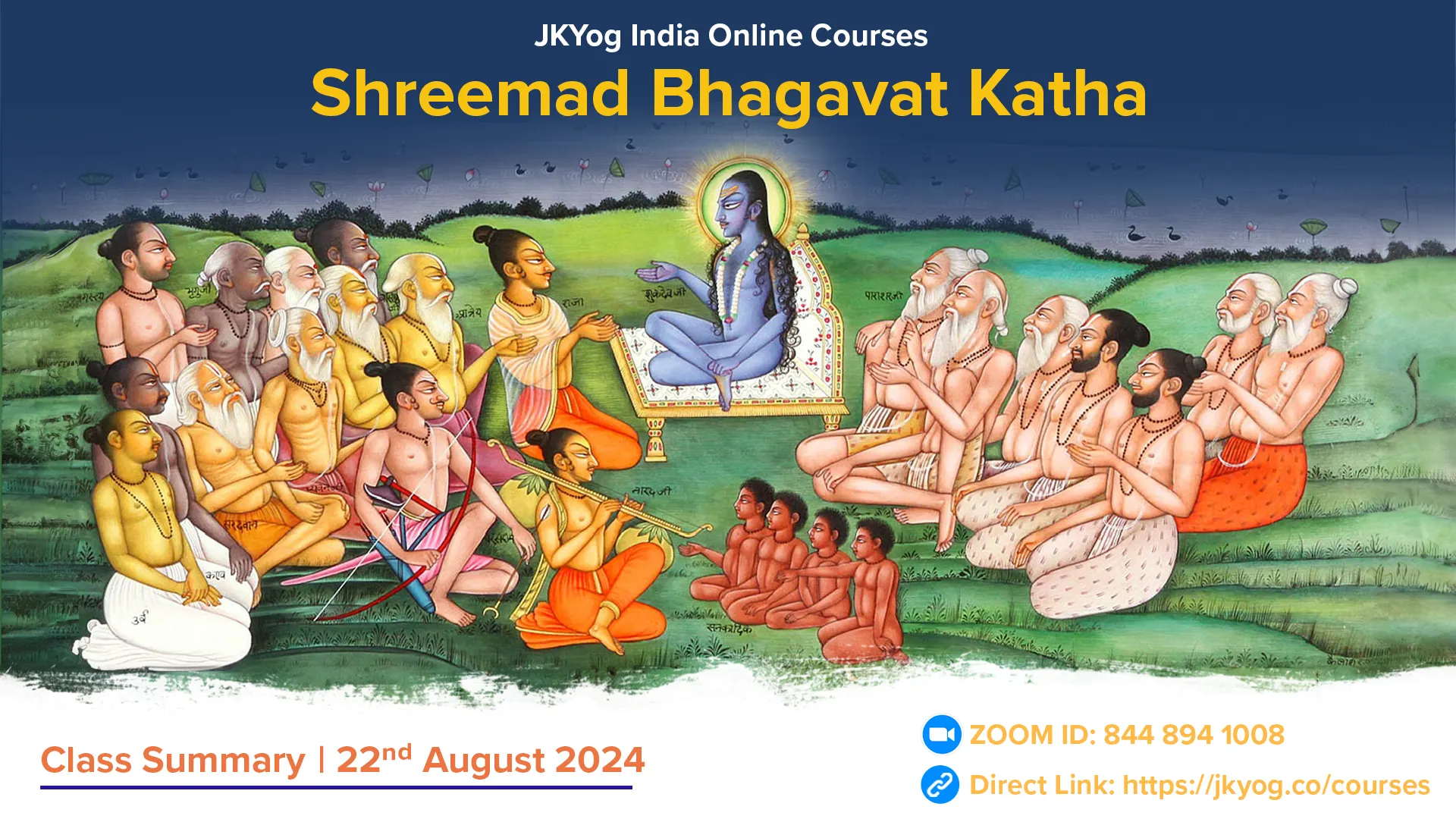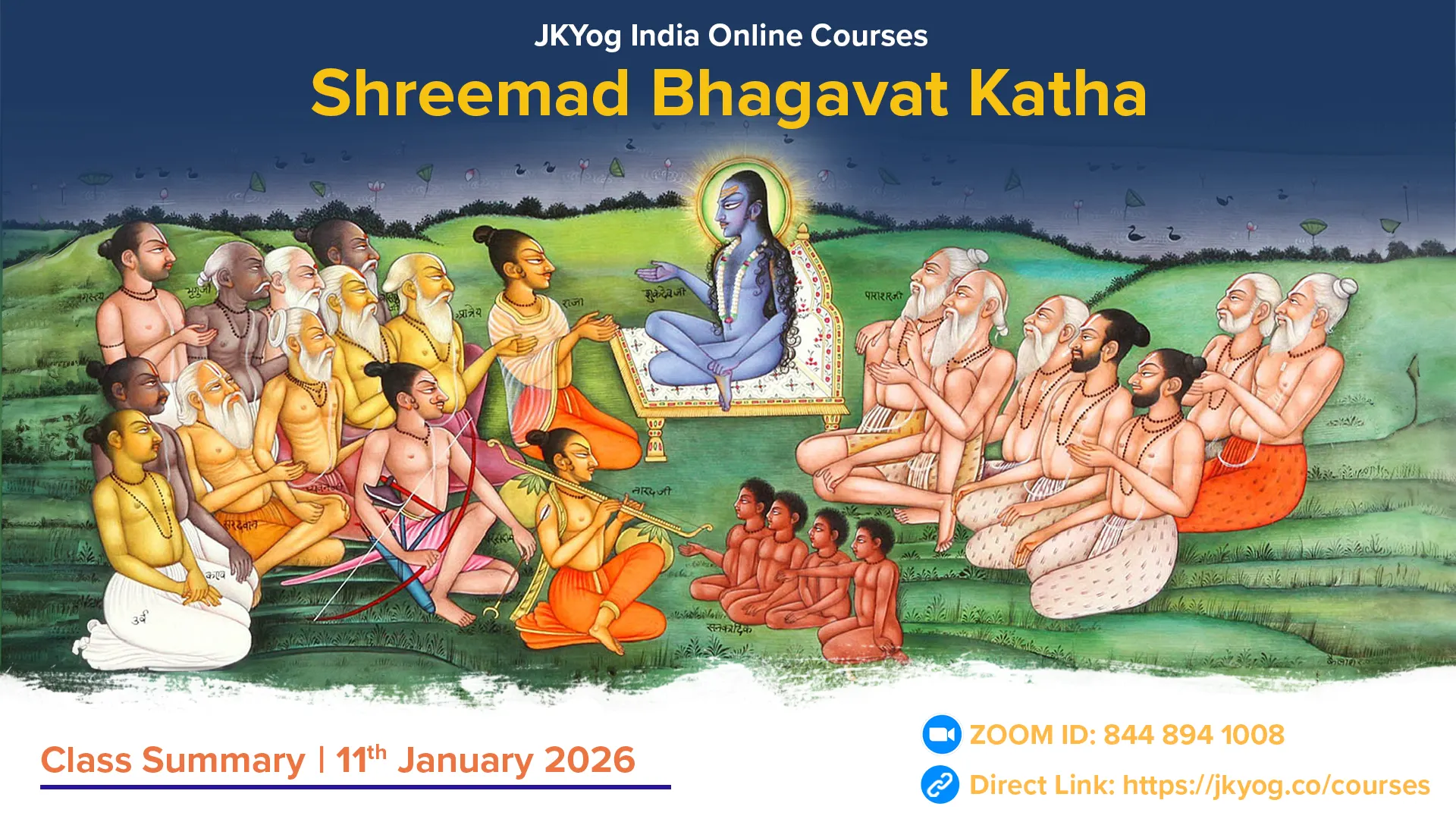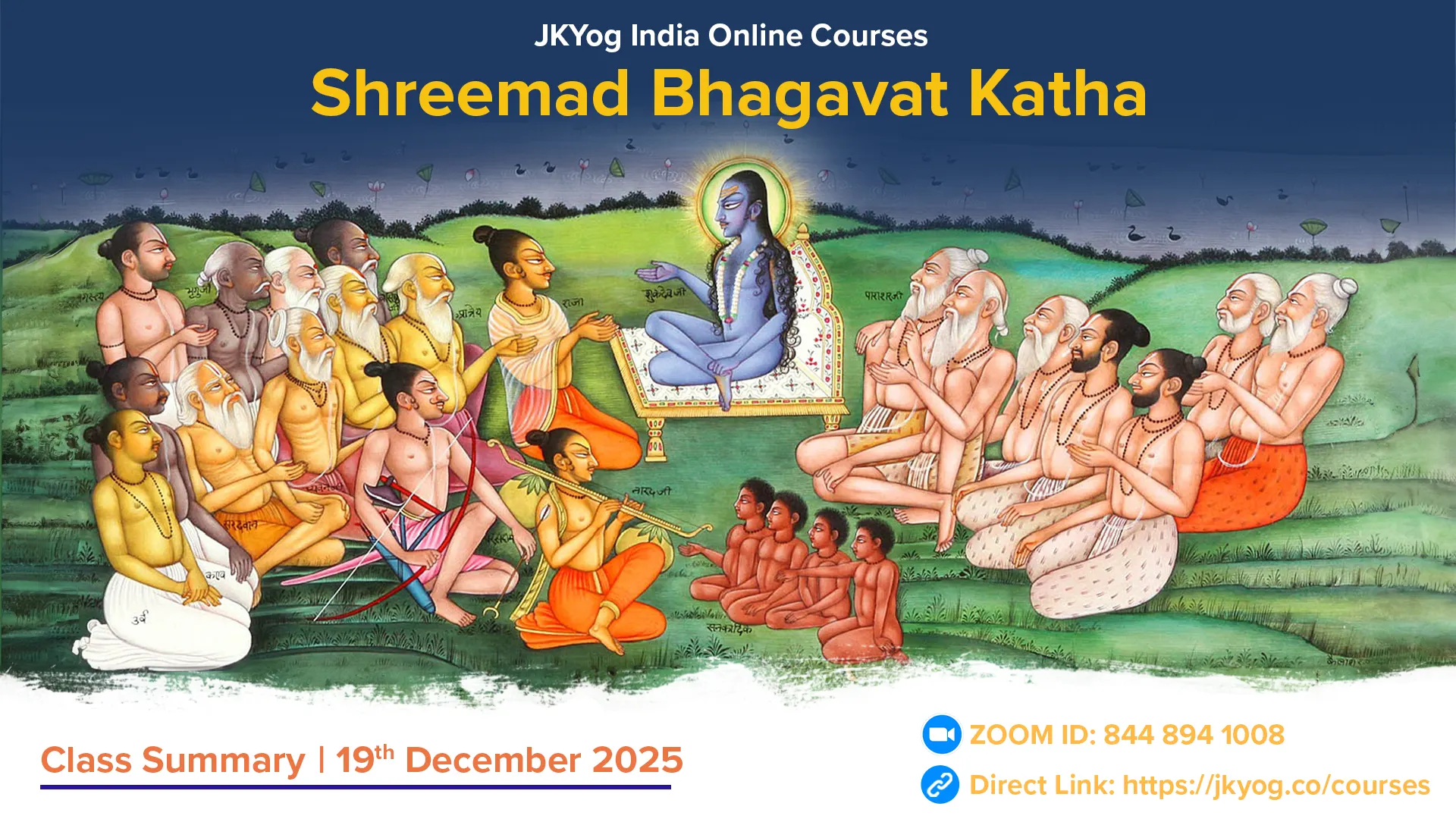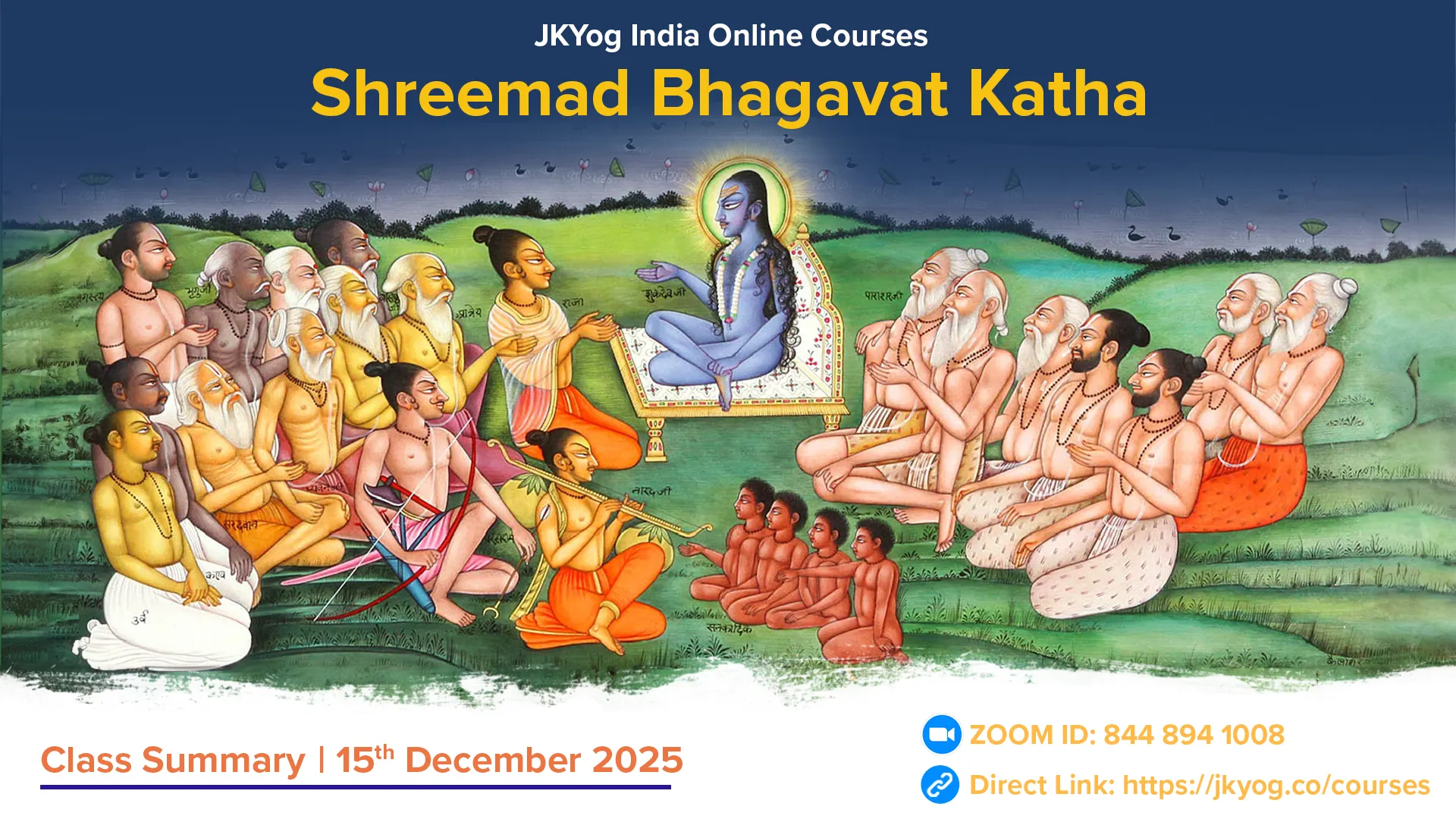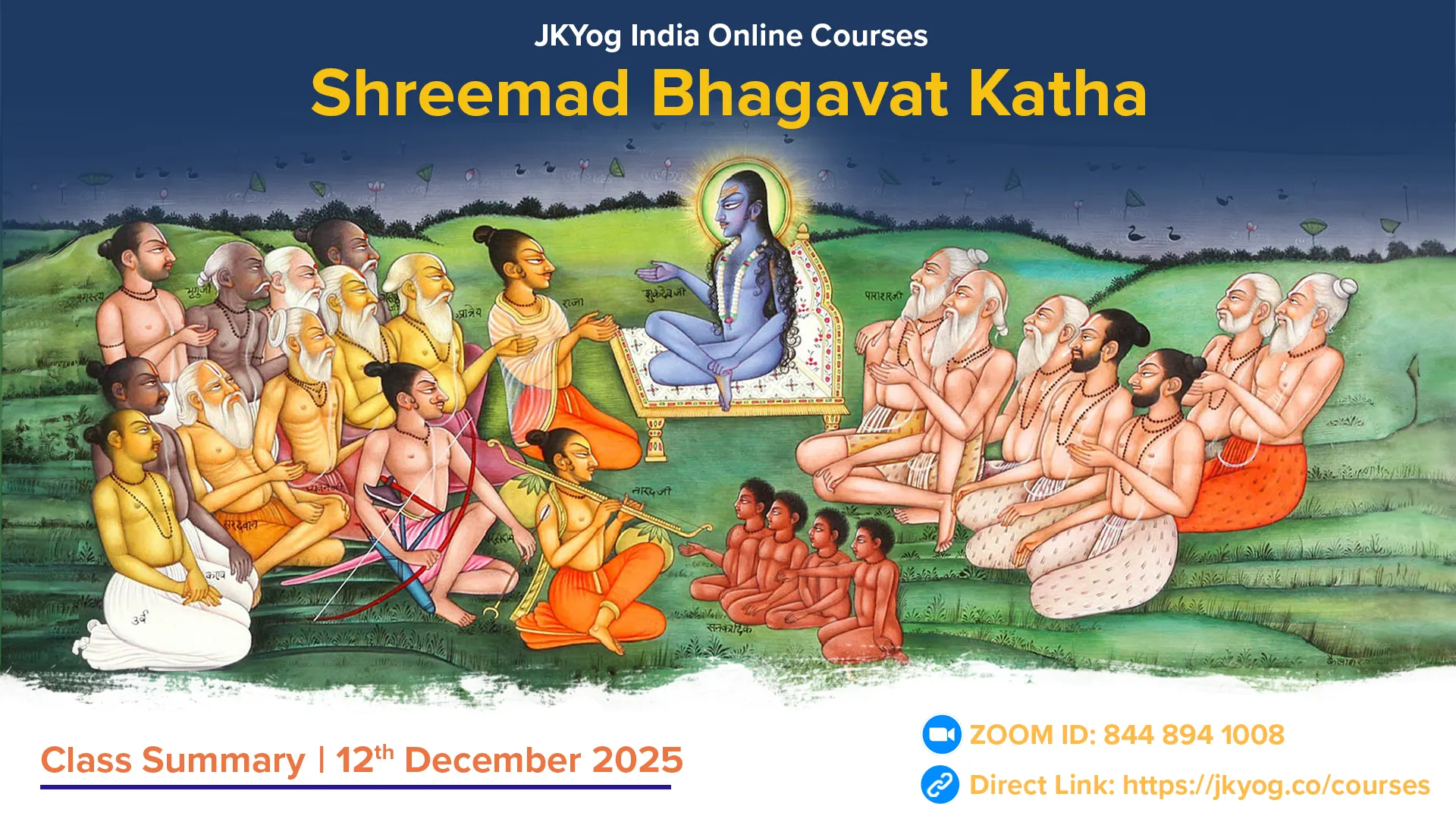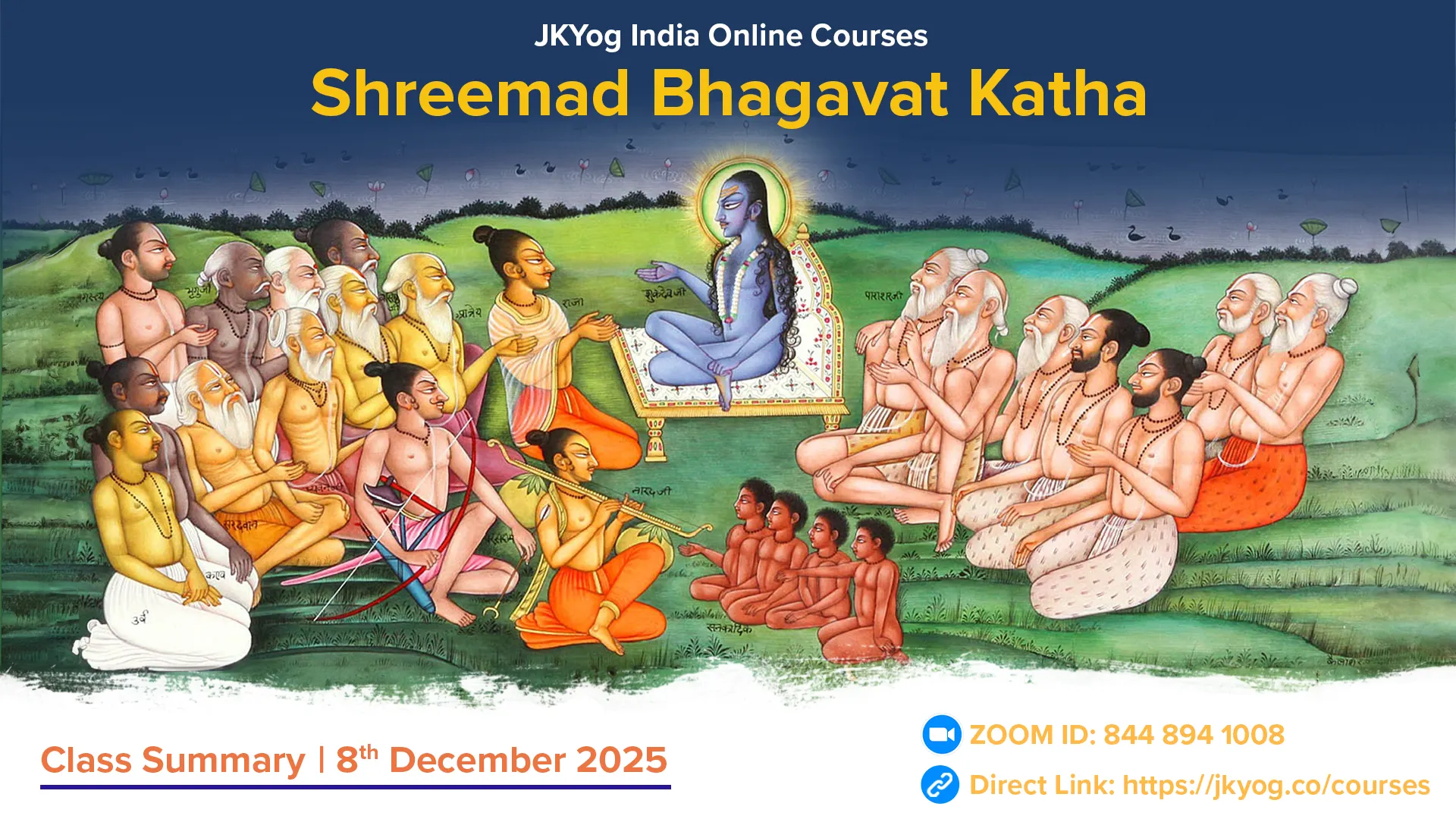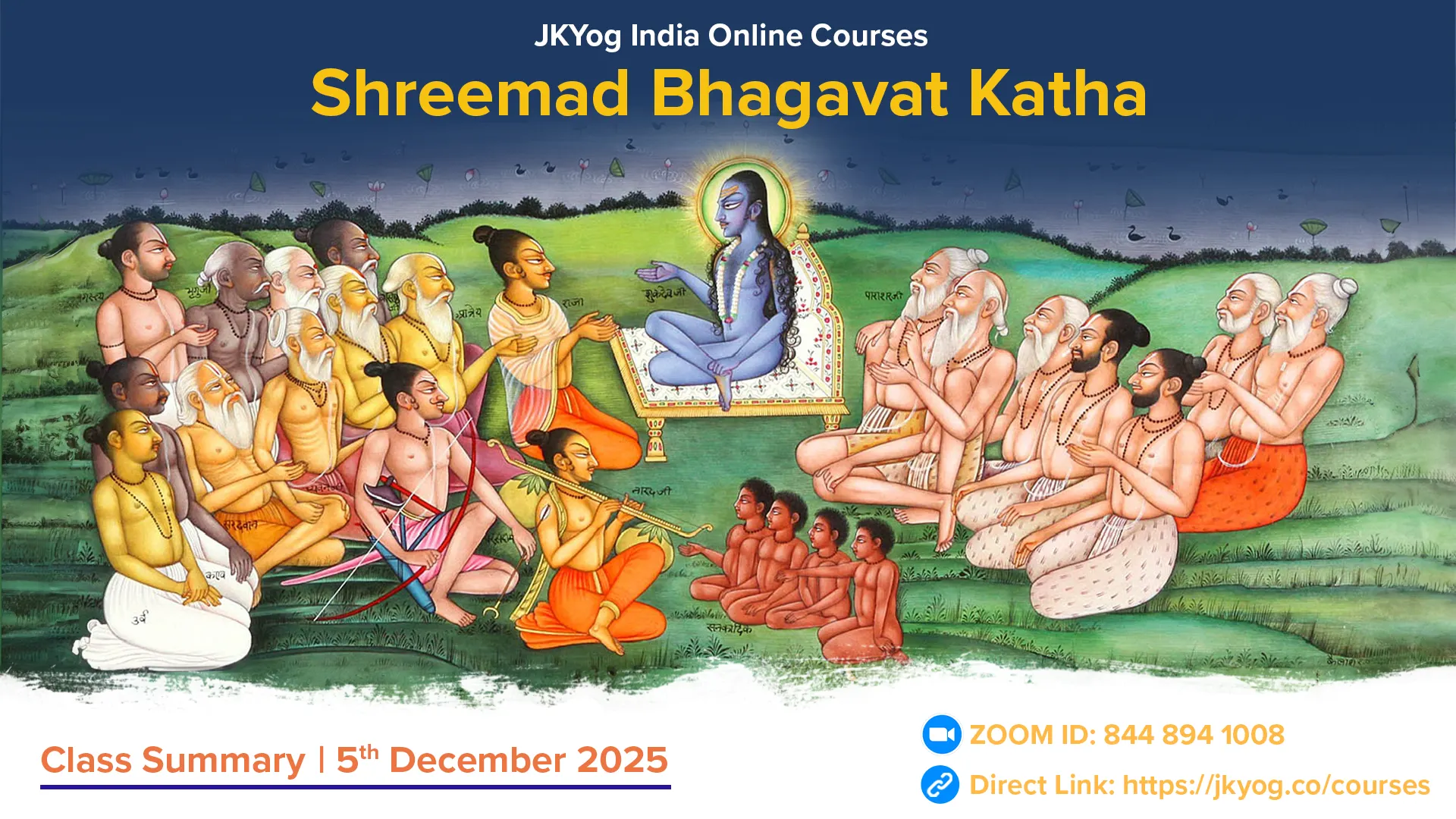Shreemad Bhagavat Mahapuran- Canto: 2, Chapters: 10
Shree Shukadevji explains to Parikshit that the Bhagavat Puran describes ten major subjects:
- Sarga: The creation of the five great elements (space, air, fire, water, Earth), the five subtle elements, the eleven senses, Mahat-tattva, and Ahankara.
- Visarga: The secondary creation which refers to the manifestation of the universe and all living beings by the Virat Purush.
- Sthana: The supreme abode of Bhagwan, known as Vaikuntha.
- Poshana: The grace and protection that Bhagwan bestows upon His devotees.
- Uti: The desires in living beings that bind them to the cycle of karma and lead to bondage.
- Manvantar: The period known as "Manvantara," during which Bhagwan's devotees govern and uphold dharma.
- Ishanukatha: The divine stories of Bhagwan's avatars and the divine tales of His devoted followers.
- Nirodh: The merging of living beings into Bhagwan during His yogic sleep.
- Mukti: Liberation, where the soul transcends ignorance and attains oneness with Brahman.
- Ashraya: The supreme entity from which the universe's creation and dissolution originate. This ultimate reality is referred to as Param Brahman or Paramatma in the scriptures.
Atra sargo visargascha sthanam poshana-mootayah
Manvantare-ishanu-katha nirodho muktir-asrayah
Dashamasya vishuddhy-artham navanam iha lakshanam
Varnayanti mahatmanah shrutena arthena cha anjasah
In the Bhagavat Purana, ten subjects are described: Sarga, Visarga, Sthana, Poshan, Uti, Manvantara, Ishaanukatha, Nirodha, Mukti, and Ashraya. To precisely determine the tenth subject, which is Ashraya, the great sages have described the other nine subjects clearly, using scriptural references, their intended meanings, and experiential knowledge that aligns with both. (Bhagavat 2.10.1-2)
What are Adhyatmik, Adhidaivik, Adhibhautik, and Adishthan?
Shree Shukadevji explains to Parikshit:
- Adhyatmik (the soul): This refers to the inner essence of the being, the soul, which perceives through the senses, like the eyes. It is the inner element of the body that experiences and acts as the observer (the atom or soul).
- Adhidaivik (the deities): These are the deities that govern the powers of the senses. For example, the Sun is the deity associated with the eyes, enabling the sense of sight.
- Adhibhautik (the body): This is the physical body made up of senses and other organs. It is the instrument through which the soul and deities perform their functions.
To understand the relationship between these three:
- Without the observer (the soul), there would be no one to perceive.
- Without the deity (like the Sun), the eyes would not receive light, making vision impossible.
- Without the object of perception (the body), there would be no eyes (senses) to facilitate the act of seeing.
Thus, without the existence of all three, nothing can function completely.
Adhishthan (Paramatma): The one who knows all three is Paramatma, the ultimate substratum and refuge of all. His refuge lies within Himself; there is no other.
Who is Narayan?
When the Virat Purush emerged from the cosmic egg- Brahmand, He began searching for a place to reside. This pure-intentioned Purush created extremely sacred waters. Since these waters originated from 'Nara' (the Virat Purush/ नर), meaning 'man' or 'cosmic being,' they were called 'Naara' (नार), meaning 'water' or 'that which originates from Nara.' The Purush then dwelled in these waters for a thousand years, which earned Him the name 'Narayana' (नारायण), where 'Naara' (नार) means 'water,' and 'Ayana' (अयन) means 'resting place' or 'abode,' thus Narayana signifies 'the one who rests on water.'
By the grace of Bhagwan Narayan, substances (matter), actions, time, nature, and living beings exist. If He were to neglect them, nothing would exist. Then, when Bhagwan Narayan awoke from His yogic sleep, He desired to manifest in many forms. With this unique desire to multiply, He, through His maya, divided His golden seed, the essence of the entire universe, into three aspects: Adhidaivik (related to the deities), Adhyatmik (related to the soul), and Adhibhautik (related to the physical world).
What are Adhidaiva, Adhyatma, and Adhibhuta?
- Adhidaiva: The Virat Purush, the all-encompassing cosmic form of Bhagwan that permeates the entire material creation, is called Adhidaiva. This is because He has dominion over all the deities and governs the various functions and divisions of the universe.
- Adhyatma: A person's own soul is referred to as Adhyatma.
- Adhibhuta: The constantly changing universe made up of the five natural elements—Earth, water, fire, air, and ether—is known as Adhibhuta.
The Expansion of the Virat Purush's Body
Shukadevji explains to Parikshit how the single virya (essence) of the Virat Purush is divided into three parts:
- When the Virat Purush moved from the space within His body, the powers of the senses, mind, and body were generated.
- The king of all, prana (life force), was born from these.
- Just as servants follow their king, when prana remains strong in the body, all the senses also remain strong.
- When prana becomes weak, the senses become inactive.
- As the prana (breath) began to move rapidly, the Virat Purush experienced hunger and thirst.
- With the desire to eat and drink, His mouth first manifested.
- From the mouth, the palate emerged, and from the palate, the sense of taste (rasanendriya) appeared.
- Subsequently, various flavours (tastes) were produced, which the tongue (rasana) perceives when the desire to speak arose, the organ of speech (vakindriya), its governing deity Agni (fire), and the act of speaking manifested.
For a long time, He remained in that water.
- When His breath's force increased, the Virat Purush's nostrils appeared.
- With the desire to smell, the sense of smell (ghranendriya) entered His nose, and its deity, Vayu (wind), manifested.
- Initially, there was no light in His body, but when He wished to see Himself and other objects:
- The apertures of the eyes, the Sun deity, and the sense of sight (netrendriya) manifested.
- Upon hearing the praise sung by the Vedic sages, He desired to hear. This led to the manifestation of the ears, the deities of the directions, and the sense of hearing (shrotrendriya).
- When He desired to feel the softness, hardness, lightness, heaviness, warmth, and coolness of objects, His skin (charma) manifested, with hair sprouting, and air also appeared.
- When He desired to perform various actions, His hands grew, and with them, the power to grasp (hastendriya) and their deity Indra manifested. This led to the manifestation of the act of grasping.
In this way, as the Virat Purush willed, His various limbs and their associated deities manifested one after another.
When the Virat Purush wished to contemplate Maya:
- His heart manifested.
- From the heart, the mind (manas) emerged as an organ.
- From the mind, its deity Chandra (Moon) and its subjects—desire and determination—appeared.
- Seven dhatus (essential elements) emerged from Earth, water, and fire within the body of the Virat Purush-skin, flesh, blood, fat, marrow, and bones.
- Similarly, pranas (vital airs) emerged from space, water, and air.
- The senses, such as hearing, perceive their respective objects, like sound, and these objects are born from Ahankar.
- The mind is the source of all modifications.
- Intellect (buddhi) is the one that enables the perception of all things.
Shukadevji concludes, "I have described to you this gross form of Bhagwan. It is enveloped from the outside by the eight coverings of Earth, water, fire, air, space, ego, maha tattva, and Prakriti. Beyond this lies the extremely subtle form of Bhagwan, which is unmanifest, devoid of attributes, without beginning, middle, or end, and eternal. Neither speech nor mind can reach there."
Bhagwan Shree Krishna Beyond the Gross and Subtle Forms
Bhagwan has two forms: one is the gross (manifest), and the other is the subtle (unmanifest). Both forms are created by Bhagwan's maya. Learned individuals do not accept these forms, as they understand that Bhagwan is truly beyond them. By nature, Bhagwan is inactive but becomes active through His power and then assumes the Virat (cosmic) form. Bhagwan manifests as both vachya (the spoken word) and vachak (the word's meaning) and takes on numerous names, forms, and actions. All names and forms in the world, such as Prajapati, deities, sages, animals, birds, trees, etc., belong to Bhagwan. All creatures, whether mobile or immobile, born of the womb, eggs, sweat, or germination originate from Bhagwan.
For the sustenance and support of the world, Bhagwan assumes the form of Vishnu and incarnates as deities, humans, animals, birds, etc., and upholds the world. At the time of pralaya (dissolution), Bhagwan takes the form of Rudra and absorbs the world into Himself, just as the wind absorbs the clouds. This is how the great souls describe the incomprehensible glory of Bhagwan. However, the wise should not perceive Bhagwan solely in terms of His roles in creation, sustenance, and dissolution, as He transcends these functions. The Supreme Absolute is not connected to the concepts of action (karma) or doership (kartapan) as defined by the processes of creation and other activities. These notions of doership are imposed by maya to negate the very idea of being a doer.
The process of creation is essentially the same in all cycles (kalpas). The only difference is that at the beginning of a great cycle (Mahakalpa), elements like Mahattattva are created from Prakriti. At the beginning of each cycle, the original creation remains as it is, while the creation of living and non-living beings occurs in a new form. The creation process is similar in all kalpas, with the main distinction being that in a mahakalpa, the creation from Prakriti includes elements like Mahattattva. In contrast, in each cycle, the creation of living and non-living beings occurs anew.
At the end of the second Canto of the Shreemad Bhagavat Mahapuran, Shaunakji asks Sootji, "Sootji! You told us that Bhagwan's great devotee, Vidurji, left his family and travelled to various pilgrims on Earth. During this journey, where did he discuss spiritual matters with Maitreya Rishi, and what did Maitreyaji teach him in response to his questions? Please narrate Vidurji's story, explaining why he left his relatives and returned to them." In response, Sootji says that King Parikshit had asked the same questions. I am now telling you What Shree Shukadevji Maharaj said in answer to those questions. Please listen carefully.
Summary: JKYog India Online Class- Shreemad Bhagavat Katha [Hindi]- 22.08.2024

